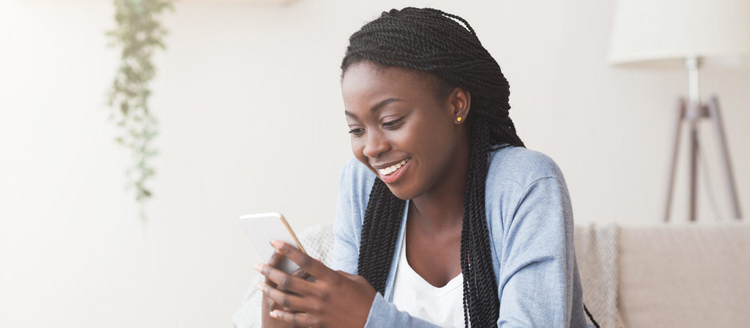Effective Customer Engagement During COVID-19 Is In Your Hands

It may seem counterintuitive, but the more time we spend at home close to our large screens during the pandemic, the more time we actually spend on our smaller, mobile screens.
Let me explain.
Yes, that big-screen TV may be within eyesight, but it is pretty much the same as anyone else’s. Your mobile phone, on the other hand, is likely your most personal piece of technology. It rings the way you want it to, receives messages from businesses you choose, and it’s almost always within arm’s length all day long.
Your phone is also increasingly being used to make purchases. Share of products purchased through smartphones increased by 10% in May compared with January (pre-COVID-19), according to new research from Adobe. And new consumers who were shopping online for the first time were doing so from their smartphones.
In addition, recent studies show other ways mobile behavior has changed: More than a third of consumers (37%) are texting more, video calling is on the rise (up 32%), and 23% are using shopping apps more, per Twigby. Mobile data use has also increased during typical working hours, per Valassis, suggesting that people are on two devices at one time.
And even before the COVID-19 outbreak, businesses were spending more of their marketing budgets on mobile, according to Deloitte Consulting and Duke University’s Fuqua School of Business. Their CMO survey, published in February, pegged mobile growth by another 72% over the next five years, to become one quarter of total marketing spend.
How spending might adjust long-term in light of the pandemic’s impact remains to be seen, although it’s clear mobile will continue to play a strong role as a channel to reach customers and prospects. Short term, and in the midst of COVID-19, how should marketers adjust their mobile strategies? Here is what Sinch recommends.
Revisit and revise your current mobile marketing playbook
The behaviors and interests of your customers and prospects likely have changed in light of the pandemic. A plan written last year fails to take any of that into account. You may be tired of the term “new normal,” but failing to understand how COVID-19 has changed your customers – 88,000 people of 211,000 surveyed by Mental Health America reported developing anxiety or depression as a result of the pandemic – would be a mistake.
Increase personalization
Personalization is more important than ever. Strategic communicators have long known that one message does not fit all. Individual preferences, taste, and culture all factor into a strategy to inform, engage, and deepen customer relationships. This is even more pronounced during the pandemic, given the vast differences among cities, states, and countries regarding the extent of the outbreak and mitigation measures.
Personalization includes your ability to demonstrate customer “foreknowledge,” which comes through real-time data. Foreknowledge demonstrates your consideration, care, and concern for each person, as well as anticipating their needs—which goes far to humanize your brand. Foreknowledge also acknowledges prior purchases, current subscriptions, or interests helping drive personalization into the conversation.
Contextual data—which can inform about location, weather, time of day, and related information—can also help you become more relevant. As cities have opened up, knowing where people are, and when they are there, has again become key in the ability to target them with relevant offers.
Market to the current mindset and conditions
Several studies show fatigue around communications that use phrases like “unprecedented time,” “cover your mouth,” and “wash your hands.” Ensure that your messaging accounts for the many feelings people have these days. Not everyone is – or will be – in the same head space, or in the same location, which may have different rules and cultural norms. The most effective marketing messages say, or imply, that the business or service is available whenever an individual is ready.
Remember you are asking for permission to enter a channel reserved for friends and family
Don’t forget this, or you’ll violate the spirit of the relationship. In this case, lessons learned way before the pandemic still ring true today, including the importance of offering opt-in, sending fewer than more marketing messages, and being sensitive to time of day. After all, few welcome a text at 3:30 a.m.
In summary, the mobile channel is an excellent conduit for businesses to reach customers and prospects — even more so amid the pandemic. For brands that want to strengthen their customer relationships via mobile during these ever-evolving times, the tips above can help them stay on top of their games.
At Adobe, we believe that everyone deserves respect and equal treatment, and we also stand with the Black community against hate, intolerance and racism. We will continue to support, elevate, and amplify diverse voices through our community of employees, creatives, customers and partners. We believe Adobe has a responsibility to drive change and ensure that every individual feels a sense of belonging and inclusion. We must stand up and speak out against racial inequality and injustice. Read more about the actions we’re taking to make lasting change inside and outside of our company.
We also know many people are still impacted by the current COVID-19 crisis and our thoughts are with you. The entire Adobe team wants to thank you, our customers, and all creators around the world for the work you do to keep us inspired during this difficult time.
